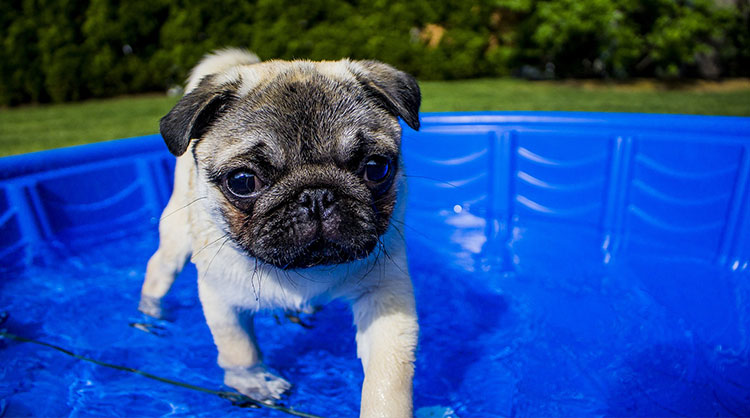Dog Swimming: Everything You Need to Know
Learn everything you need to know to take your furry friend’s swimming skills to the next level. Read on for our ultimate guide on dog swimming!
DOGS

Posted by bravectosouthafrica – 28 November 2019
- Can all dogs swim?
- A history of good swimming dogs
- 10 best swimming dog breeds
- 10 worst swimming dog breeds
- How to teach a dog to swim
- Why dog swimming is a good idea
- Safety precautions
- Hydrotherapy for dogs
- Best dog pools
- Do some cats enjoy swimming?
- Will swimming kill ticks, fleas and ear mites?
You might think that your dog is a natural-born swimmer. On the contrary, the dog swimming motion is an extension of their land trot. Dogs are not born with a unique gene that enables them to effortlessly glide through water. Their automatic paddling response is as far as their ability stretches, and for some pups it’s not enough to keep them afloat.
According to Dr Becker, “dogs generally fall into one of three categories when it comes to swimming. There are dogs that naturally take to the water, those who just aren’t built for the water and should stay safely ashore (unless in a hydrotherapy tank with a therapist hovering nearby), and dogs who can be taught to swim.”

Can All Dogs Swim?
Let’s face it. Some dogs simply aren’t built for swimming. Small, top-heavy dogs, especially brachycephalic types, (short-nosed breeds), like pugs, are likely to sink instead of swim – despite their efforts. Their mini legs aren’t strong enough to propel them through water, and to top it all, their lower limbs work overtime, tiring these pups out even more. Medium and large dog breeds are often more adept at swimming – however that’s not always the case. Larger dogs, like chow chows and boxers, can’t swim too well either.
Enter the dog life jacket – a real lifesaver
Make sure that your dogs do know how to swim or train inept swimmers to stay far from water. Most importantly, equip your pup with a dog life jacket while training.
Do You Know How Dogs Swim?
Dr Frank Fish, a biology professor at West Chester University, analysed the movement of dogs in water and discovered that dog swimming resembles a dog’s land trot. During this motion, a dog’s opposing legs move together, i.e. the right front and left rear legs. While swimming, pups use this movement, only quicker. The doggy paddle is the standard swimming method for all dogs, big or small, and for some humans too!

A History of Good Swimming Dogs
Water dogs, dogs with particular traits, like webbing between their toes and a water-resistant coat, were bred to assist in work in and around water. Canines, such as Labrador retrievers, would help fishermen haul nets and ropes, as well as retrieve fish from the water. These water-loving dogs could work well both on land and at sea.
Did you know that most of the adored modern retriever breeds come from water dog breeding? Read on to get to know the ancient water dog!
What Is a Water Dog?
Water dogs, known for their waterproof coat, amongst other traits, are medium-sized canines that relish a good swim. Mariners used the ancient ancestor breed to retrieve whatever fell overboard, as a messenger in-between boats, and for rescue or hunting purposes.
These dogs were even used by the Spanish Armada throughout the 20th century. Medieval Europe also employed water dogs to retrieve fowl and arrows from water. However, nowadays most of these strong swimmer dogs are ornamental.
Ancient Water Dog Breeds
- The Spanish water dog
- The Portuguese water dog
- The Tweed water spaniel
- The English water spaniel

10 Best Swimming Dog Breeds
Although there is no special swimmer gene, some dog breeds certainly seem like naturals when they take to water. These dogs include most retrievers and dogs with “water” in their name, like the Spanish water dog. Webbing between their toes makes these breeds exceptionally skilful swimmers.
Here are the super swimmers:
- Water spaniels
- Newfoundland
- Poodle
- Most retrievers
- Setters
- Pudelpointer
- Lagotto Romagnolo
- Barbet
- Otterhound
- Boykin spaniel
10 Worst Swimming Dog Breeds
Cute and perky breeds, especially the plump ones, are often those who can’t even paddle their way through a shallow stream. When poor swimmers do decide to dive in, they might just threaten their own existence without proper training and a life vest.
Here are the frightfully weak swimmers:
- Bulldog
- Pug
- Pekingese
- Basset hound
- Boxer
- Dachshund
- Maltese
- Chow chow
- Corgi
- Shih tzu

All is Not Lost! Here’s How to Teach A Dog How to Swim and Conquer the Blue
Whatever your pup’s stature, you can try to teach them how to swim. However, remember to take safety precautions at all times – scroll down to learn more.
Teach Your Dog or Puppy to Swim in 5 Easy Steps
1. Determine if your dog enjoys being in the water.
Before teaching your dog how to swim, you need to see whether they enjoy being in the water – not all dogs do. They might grow to like it but if they don’t, find another activity they’ll adore instead.
2. Start with a dog pool.
Start with a shallow dog pool filled with lukewarm water. Lure your pup into the pool with a toy or snack. They should be able to stand comfortably with their heads above water.
3. Use encouragement.
Keep your tone light and positive while encouraging your pet with treats or toys when they behave appropriately or courageous.
4. Create a post-swim ritual.
After the lesson is over, create a post-swim routine that teaches safe practices – e.g. getting out of the pool by using the pool steps, a dog pool ramp or climbing out of the boat. Rinse your pup with fresh water to keep their coat healthy and algae-free.
5. Reward your pup when it’s all over.
Reward your dog when the swimming lesson is over. Give them positive affirmation and physical praise to help your pet to associate swimming with fun.
Tips to Make Training Easier
- Use a smaller dog paddle pool. Large bodies of water may intimidate your pup.
- Train your dog as soon as possible. A baby pool or bathtub is a good way to introduce a little puppy or small dog to swimming.
- If steps are too daunting, take your dog to a lake where they can gradually go deeper. Remember their dog life jacket – safety first!
- Don’t throw your dog into the pool, ever.
- Train in a tranquil environment – limit noise and other distractions.
- If you’re training in a lake or salt water, take along fresh, clean water that your dog can drink.
- Get your dog used to a dog life jacket by starting training sessions by putting it on.
- Use obedience training to teach your dog to come when called and to stop something they shouldn’t be doing – it might save their life.

Why Dog Swimming Is a Good Idea
Not only is swimming good for your pup’s emotional wellbeing, but a host of other benefits also make taking a dip all the more enticing.
Easy Exercise
Dogs, like their humans, need regular exercise to stay in good shape. A daily jog or walk is a good idea, unless it’s sweltering outside. On hot days watercise is best. Dog swimming is a great way to ensure your pet stays fit and cools down in the heat.
A water workout is low-impact, which means it’s better for your pet, as it isn’t harsh on joints and paws. It’s even better for senior dogs suffering from arthritis, because swimming regularly will strengthen their muscles and improve their cardiovascular system – pain-free!
Recovery
Gentle swimming for dogs or water therapy is often prescribed for dogs recovering from medical procedures, torn ligaments or those who have arthritis. The resistance and low-impact exercise join forces to improve your pup’s flexibility, muscle tone, and heart function. Movement, within means, is essential to a pet’s recovery. Ensure your dog is not regressing by encouraging them to move around in the pool or head to pup physio for help.
Remember to consult your veterinarian before implementing a new treatment.
Weight Loss
Not all dogs can go for a jog. Big pups tend to get aches and pains easily because of the strain their weight places on their joints. Happily swimming is low-key when it comes to paw pressure. Plus, it’s a full-body workout!

Dog Swimming Safety Precautions
Taking safety precautions is essential to every swim – even for your water-loving pup.
Supervision is Critical
Ensure pools, as well as entry to lakes or ponds, are fenced off and supervise your pups when they swim.
Passive Supervision
Passive supervision is when you’re near your pet but not paying attention to where they are or what they’re doing.
Reactive Supervision
Reactive supervision is when you react when something is happening at that moment. The problem with reactive supervision is that your reaction could be too late or your dog could form a negative association to the occurring situation and become fearful or even introverted in similar circumstances.
Proactive Supervision
Proactive supervision involves managing a pet’s environment to create a calm and healthy space for them to grow – e.g. attentively walking between your dog and the pool to keep them from plunging in.
Active Supervision
Here the pet owner will guide the dog within the swimming pool and actively encourage behaviour that aligns with safe dog swimming practices.
Add a Dog Swimming Ramp
if a dog does take a dip or fall in the water, a ramp will help them to get out safely. Your pup will be able to paw his way out of the water and onto the sloped surface.
Practice
Even if your pet is a water-lover, teaching them safe habits will decrease the chances of an accident. Implement dog swimming training until your pet is confidently familiar with safe swimming practices. Teach your pet when it’s appropriate to jump into the pool – after a whistle or a note of encouragement – and where they need to paddle to get out, e.g. the pool steps.
Use a Dog Life Jacket
Get your pup a dog life jacket or a swim vest as an extra, yet necessary, precaution.
Keep Extra Dog Toys on Hand
If your pup is happily paddling towards oncoming doom in the pursuit of a stick, lure him back with a second, more attractive toy.

Hydrotherapy for Dogs – Water Is More Than a Fun Pastime
Strictly speaking, hydrotherapy for dogs is not swimming. Some water activities are therapeutic. Hydrotherapy for dogs helps to reduce inflammation and discomfort. Water healing can be as beneficial for dogs as it is for humans.
Veterinarians use dog pools, underwater treadmills and whirlpools for treatments. Water therapy helps dogs receive the necessary resistance training that’ll increase circulation and joint flexibility without placing strain on their joints. Trudging in water will also help strengthen muscles, boost endurance, flexibility and agility.
The Value of Canine Hydrotherapy
By using hot and cold water, therapists can induce various forms of muscle relaxation and spasm to treat medical conditions, shorten recovery time and strengthen your pet’s muscles. Water treatment may also decrease pain and stress while building energy, coordination and balance.
Hydrotherapy with hot water encourages sweating and muscle relaxation to improve circulation, arthritis, rheumatism and muscle pain. Cold water, on the other hand, affects deep tissue and blood circulation, which can ease pain after surgery and sprains.
5 Benefits of Hydrotherapy for Dogs
- Improved circulation
- Healthier skin and coat
- Detoxification (lymph drainage)
- Improved balance and coordination
- Better digestion
Consult your vet before trying hydrotherapy for dogs. Some dogs with an ear or eye condition should steer clear of water until their issue has cleared up. Water can aggravate the problem.

Best Dog Swimming Pools
Dog pools are specifically designed for when your furry friend wants to take a dip. These are shallow pools, similar to kiddie splash pools, which are puncture-proof and built to withstand the wear and tear that the furriest family member is bound to cause.
Once you browse through the numerous dog swimming pools available, you’ll soon realise that they come in all shapes and sizes, to fit your pup perfectly. From spacious dog swimming pools, to a fun dog bone pool, to a dog paddling pool – your pup is spoiled for choice! If your dog is not a swimmer but needs to cool down, invest in a cooling gel pet bed, or a doggy fountain, instead.
You might be tempted to have your little ones share the dog pool, but for hygienic reasons it’s best to keep the human and canine pools separated.
Not Interested in Buying? Make a DIY Dog Pool Instead
If you have a knack for doing things yourself, and a garden to play in, make a DIY dog pool for your favourite furry friend! You can even go further with a dog pond – they’ll love it!

What About Cats, Do Some of Them Enjoy Swimming?
Frankly, most cats dislike swimming. An innocent dip in the water can turn a composed kitty into a crazed, scratching and soaked fur ball in seconds. Nonetheless, some cat breeds enjoy water, particularly in hot, dry climates. A few felines may even like an occasional refreshing soak.
2 Main Reasons Why Your Cat Dislikes Swimming
1. Their Coats Dry Slowly
Most cat coats take longer to dry than a dog’s, which is one reason why they’re not too fond of taking a dip or a bath. Keep in mind that bathing a cat is unnecessary, unless the feline is in a particularly dirty state, their grooming is often enough. If bathed, your cat might suspect that you’re purposefully trying to make their grooming regimen more arduous than it needs to be.
2. They Dislike the Lack of Control
In water, felines are sluggish and not nearly as nimble as they are on land. Cats thrive because of their agility and the lack thereof, when they’re trudging through liquid, is surely off-putting.
Since not all kitties are skittish when it comes to H2O, you can test whether your cat is a possible swimmer by training them correctly. Similar to canines, do not throw your cat in water, ever. They’ll be sufficiently freaked out to never want to go near water again.
Cats That Enjoy Getting Their Paws Wet
- Maine Coons
- American shorthair
- Bobtails (American and Japanese)
- Turkish angora
- Norwegian forest cats
- Turkish Van cat
- Bengal
Remember to take safety precautions for all of your pets when around bodies of water. Even if your cat enjoys the dog paddle, make sure they know where and how to get out of the water when they need to.

Will Dog Swimming Kill Ticks, Fleas and Mites?
Ticks, fleas and mites are hardy and don’t die easily. If you plan on submerging your pup in water to get rid of a pest, think again. Fleas jump to safer, drier, grounds when water is near, ticks don’t drown quickly and mites are quite safe, nestled snugly in your pet’s skin or ears. That’s why it’s crucial to deal with parasitic pests head on. Use a pest preventative treatment like Bravecto®.
As a tasty treat, the Bravecto® Chew provides 12 weeks tick, flea and mite protection for your pooch. Bravecto® Spot-On for Dogs keeps tick away for 4 months, while fleas stay away for 6 months. Cats are covered with Bravecto® Spot-On for Cats too, providing 3 months of protection against ticks, fleas and ear mites.
Does Swimming Affect Pest Preventative Treatment?
Fortunately, after waiting 72 hours, Bravecto® products don’t wash off once they have been fully incorporated into your pet’s bloodstream. The Bravecto® Chew is wholly unaffected by water, as it’s consumed internally.
Are you ready to splash around with your favourite furry family member? Grab your pet’s dog life jacket and adhere to swimming safety best practices to protect them in the water. For their outdoor pest protection, get Bravecto® and experience life free from ticks, fleas and mites!
Learn more about Bravecto® products or find a stockist near you today!
Subscribe to our Newsletter
Get to know your furry friend better! Sign up for all things dog- or cat-related.
The Hairy Facts about the dreaded hairball
12 April 2021
Help! My dog’s barking mad! Volume 2
12 April 2021
Your Itchy, Scratchy Cat – All About Cat Skin Problems
12 April 2021
The Dog’s Diet: A Bone of contention?
01 April 2021
Mango Fly Worms: How to Spot and Eliminate them
Posted on November 28,2019
Managing Mange And Mites In Your Dog
Posted on June 11,2018
Why Do Cats Purr and How? Learn What Your Cat Is Saying
Posted on October 14,2020
How to Get Rid of Ear Mites in Dogs
Posted on November 06,2019









